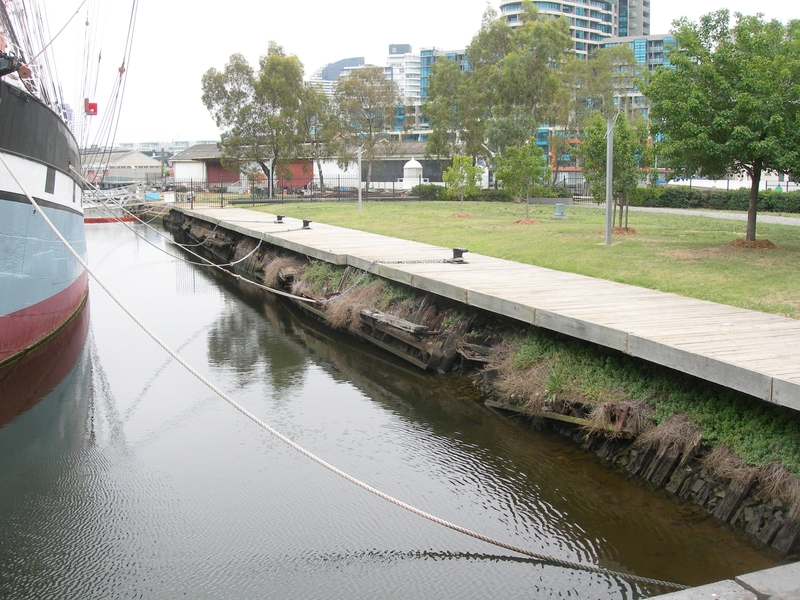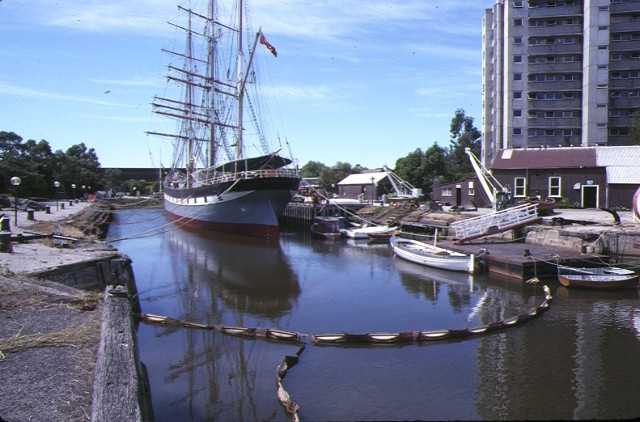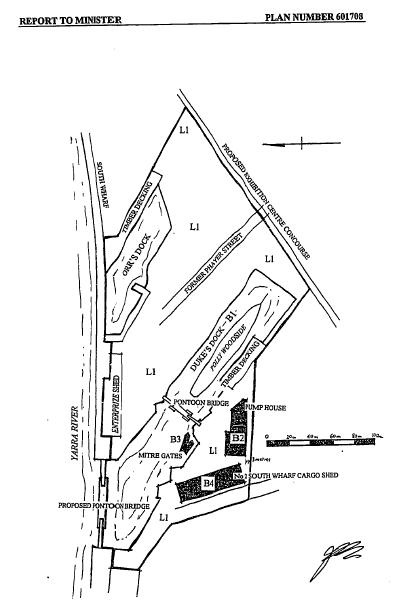DUKE AND ORRS DRY DOCK
1-27 SOUTH WHARF PROMENADE SOUTH WHARF, MELBOURNE CITY
-
Add to tour
You must log in to do that.
-
Share
-
Shortlist place
You must log in to do that.
- Download report




Statement of Significance
What is significant?
Duke and Orr's Dry Dock is a large timber lined dock which currently houses the historic barque Polly Woodside. It was built in 1875 and was largely reconstructed in 1901 with a new pump house, plant and machinery. The dock, gates, machinery and pump house are largely intact, although the basin of the dock has been partially filled and reduced in length. The dock is now approximately 107m long, 24m wide and 7m deep.
How is it significant?
Duke and Orr's Dry Dock is of historical and scientific (technical) significance to the State of Victoria.
Why is it significant?
Duke and Orr's Dry Dock is of historical significance as one of the few surviving relics of a once extensive ship building and repair industry that stretched along the south bank of the Yarra River for 5 kilometres below the Queen Street Bridge. Its location is a reminder of the once close proximity between the CBD and its port facilities, a proximity that was interrupted by changed cargo handling methods and larger ships. At the time of its closure in August 1975 it was the oldest and longest operating privately-owned dry dock in Victoria, having been in almost continuous operation for one hundred years. Associated buildings provide an important and authentic aspect of the dock's historical context as do the cobbled bluestone laneways that formed Tyne Street and Phayer Street which contribute a significant historical aspect to the precinct.
Duke and Orr's Dry Dock is of scientific (technical) significance as the last timber walled dry dock to operate in Australia and because of its unique steam plant which includes the oldest known surviving installation of Victorian-built underfired tubular boilers in the metropolitan area, and the only extant pair of Victorian-built tandem compound vertical steam pumping engines.
-
-
DUKE AND ORRS DRY DOCK - History
Contextual History:History of Place:
In 1874 the Melbourne shipwright, George Sampson Duke, obtained a lease over 3 acres of Crown Land on the south bank of the Yarra to build a dry dock. The site had previously been occupied as a dock by Thos. Norton. Duke's Dock was completed in the first half of 1875. Its original dimensions were 310 ft long, 40 ft wide at the gate and 54 ft wide in the middle. It was capable of holding vessels with a draught of 14 ft. It had a timber floor, walls and gate. Due to a government river widening project Duke lost a portion of his lease, receiving additional land on a 21 year lease as compensation. Using this new land, Duke extended his dock at the southern end by 300 ft and created a double docking space. In 1881 the outer gate was moved back clear of the land owned by the Melbourne Harbour Trust so that the Trust could construct a moveable bridge. In the process Duke lost 120ft of dock and received 6250 pounds compensation. Changing shipping requirements by the 1900s led to further reconstruction of the dock. By 1904 the dock had been reconstructed to the following dimensions: length 520 ft on top and 510 ft at bottom; width 71 ft top and 61ft 9 in bottom; depth 23 ft. New mitre gates were constructed and new pumps, engines and boilers installed.
In 1910 Duke's dock was merged with Orr's smaller dock immediately upstream to form Duke and Orr's Dry Amalgamated Docks Ltd. Orr's dock was closed in the mdi-1930s.
The dock was mostly closed between 1923 and 1926 for repair works for damage caused by several floods. In 1935, after the floor of the dock blew out in a flood, the floor was completely replaced with concrete and the length of the dock extended to 527 ft.
As the shipping industry continued to change in the 20th century, the dock became less functional and was eventually closed in 1975 after the construction of a new bridge at Johnson Street closed access to it by ships.
In 1977 the site was ceded to the National Trust of Australia (Victoria) and became the berth of the Polly Woodside.DUKE AND ORRS DRY DOCK - Permit Exemptions
General Exemptions:General exemptions apply to all places and objects included in the Victorian Heritage Register (VHR). General exemptions have been designed to allow everyday activities, maintenance and changes to your property, which don’t harm its cultural heritage significance, to proceed without the need to obtain approvals under the Heritage Act 2017.Places of worship: In some circumstances, you can alter a place of worship to accommodate religious practices without a permit, but you must notify the Executive Director of Heritage Victoria before you start the works or activities at least 20 business days before the works or activities are to commence.Subdivision/consolidation: Permit exemptions exist for some subdivisions and consolidations. If the subdivision or consolidation is in accordance with a planning permit granted under Part 4 of the Planning and Environment Act 1987 and the application for the planning permit was referred to the Executive Director of Heritage Victoria as a determining referral authority, a permit is not required.Specific exemptions may also apply to your registered place or object. If applicable, these are listed below. Specific exemptions are tailored to the conservation and management needs of an individual registered place or object and set out works and activities that are exempt from the requirements of a permit. Specific exemptions prevail if they conflict with general exemptions. Find out more about heritage permit exemptions here.Specific Exemptions:Former Number 2 South Wharf Cargo Shed: Realignment or relocation of shed within the precinct.
-
-
-
-
-
FORMER GOLLIN AND COMPANY BUILDING
 Victorian Heritage Register H0685
Victorian Heritage Register H0685 -
OLD BOURKE STREET WEST POLICE STATION AND CELL BLOCK
 Victorian Heritage Register H0655
Victorian Heritage Register H0655 -
ST AUGUSTINES CATHOLIC CHURCH AND FORMER SCHOOL
 Victorian Heritage Register H0002
Victorian Heritage Register H0002
-
'The Pines' Scout Camp
 Hobsons Bay City
Hobsons Bay City -
106 Nicholson Street
 Yarra City
Yarra City -
12 Gore Street
 Yarra City
Yarra City
-
-












